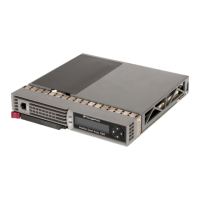HP StorageWorks 1000/1500 Modular Smart Array Command Line Interface user guide 31
Extending a LUN
CAUTION: In an HP-UX environment, extending a LUN as described in this section is not supported. See
the HP-UX documentation for instructions on extending LUNs on an HP-UX system.
To incorporate unused, available space in an array to a specific LUN:
Basic command
extend unit <#> [new_size=syy|add_size=syy]
Command options
#—the LUN to which the space will be added.
add_size=syy—how much of the available space in the array to add to the LUN, where s represents
the size, and yy indicates GB, MB, or KB. If no size is specified, the maximum available space of the
included disks will be assigned to the array.
new_size=syy—can be used instead of add_size to enter the total new size of the LUN, where s
represents the size, and yy indicates GB, MB, or KB.
Example command and response
CLI> extend unit 2 add_size=1000mb
The actual new volume size will be 1992MB.
Unit 2 is being extended.
Use “show unit 2” to monitor progress.
Migrating a LUN to a different RAID level
While obeying the constraints of included number of drives and applicable stripe sizes, you can migrate
an array from one RAID level to another. If you attempt to move to an unsupported RAID configuration for
an array, an error message is displayed.
NOTE: Before changing the RAID level or stripe size of a LUN, verify there is available, unused space on
the array. Migrating from one RAID level to another may require additional space for parity and
organizational purposes.
Basic command
migrate unit <#> [raid_level=r] [stripe_size=s]
Command options
#—the number of the LUN to modify.
raid_level=r—the RAID level to migrate to. RAID levels include:
0 = RAID 0 (no fault tolerance)
1 = RAID 1 (mirroring)
5 = RAID 5 (distributed parity)
6 = RAID 6 (advanced data guarding (ADG))
stripe_size=s—(optional) the stripe size to use. Options include:
RAID 0 can use stripe sizes 8, 16, 32, 64, 128, and 256 (Default: 128 KB)
RAID 1 can use stripe sizes 8, 16, 32, 64, 128, and 256 (Default: 128 KB)
RAID 5 can use stripe sizes 8, 16, 32, and 64 (Default: 16KB)
RAID 6 can use stripe sizes 8, 16, 32, and 64 (Default: 16 KB)
Example command and response
CLI> migrate unit 0 raid_level=5 stripe_size=32

